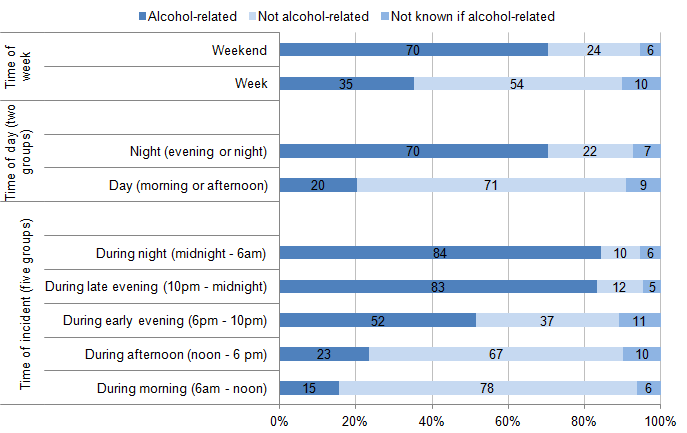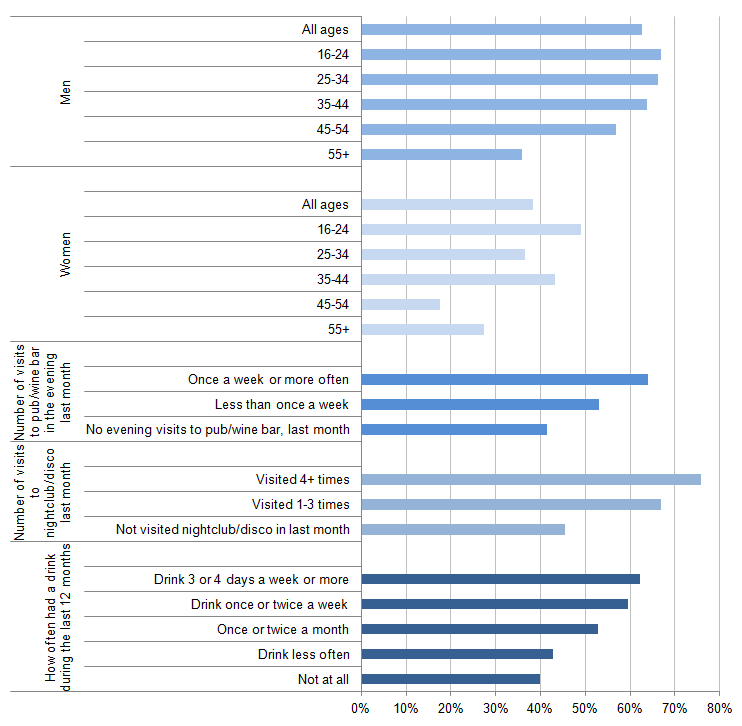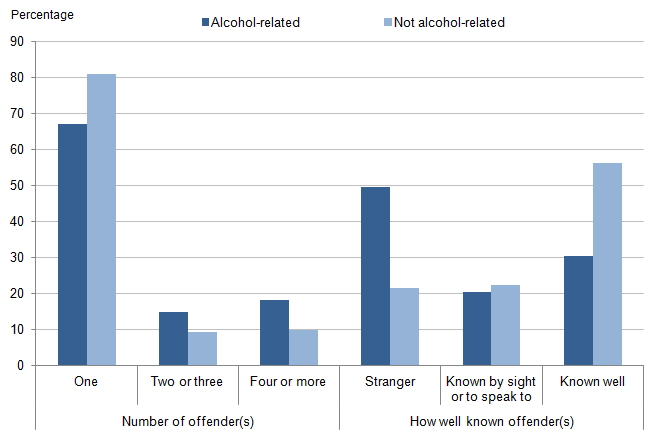1. Summary
This chapter presents findings from the 2012/13 and 2013/14 Crime Survey of England and Wales (CSEW) on violent incidents where alcohol has been a factor. Additional analysis is also provided from the Home Office Data Hub, a record level dataset of police recorded offences.
Victims perceived the offender(s) to be under the influence of alcohol in 53% of violent incidents measured by the 2013/14 CSEW. This is equivalent to an estimated 704,000 ‘alcohol-related’ violent incidents. While the volume of incidents has fallen, the proportion of violent incidents that were ‘alcohol-related’ has remained relatively steady over the last ten years
Alcohol was a particularly prevalent factor in violent incidents between strangers, 64% of which were perceived to be alcohol-related (CSEW 2013/14)
In the combined datasets of the 2012/13 and 2013/14 CSEW, 70% of violent incidents occurring at the weekend, and 70% of violent incidents occurring in the evening or night, were alcohol-related
The proportions of violent incidents that were alcohol-related increased as the afternoon and evening progressed, from 23% of violent incidents occurring between noon and 6pm, to 52% were between 6pm and 10pm and 83% occurred between 10pm and midnight
70% of violent incidents which took place in a public space were alcohol-related compared with 40% of incidents that occurred in the home and 43% of incidents that happened in and around the workplace
Where injuries were sustained these were typically more severe in incidents of alcohol-related violence compared with other violent incidents. Victims in alcohol-related violent incidents were more likely to have received cuts (15%, compared with 9% of victims in non alcohol-related incidents) or to have suffered concussion or loss of consciousness (5%, compared with 1% of victims in non alcohol-related incidents) as a result of the incident
2. Introduction
This chapter looks at the extent, nature of, and trends in, alcohol-related violent incidents experienced by adults aged 16 years and older resident in households in England and Wales. It presents data on the extent of alcohol-related violence from the 2013/14 Crime Survey of England and Wales (CSEW) and also includes more detailed analysis of the nature of this type of violent incident based on combined data from the 2012/13 and 2013/14 surveys. Combining data from two survey years increases the number of incidents available for analysis of the more detailed breakdowns of the data.
Further information on the involvement of alcohol as a factor in violent incidents is provided from the Home Office Data Hub, a record level dataset of police recorded offences which contains more detailed information on crimes than the main police recorded crime data collection. As there is no specific offence of alcohol-related violence defined in law the aggregate police recorded crime data collection does not separately identify this type of crime. However, the Data Hub contains a field where police forces can identify a given set of aggravating factors related to an offence and one of these factors is whether the offence was ‘alcohol-related’. It is not mandatory for forces to populate this field and not all forces are presently supplying crime data to the Home Office via the Data Hub. Analysis using these data is therefore limited to 21 of the 43 territorial police forces of England and Wales, and is subject to continuing quality assurance. These forces account for over half (61%)1 of the violence against the person offences in England and Wales and include data from the Metropolitan Police, who alone record around a fifth of offences in England and Wales.
This analysis of the Data Hub was restricted to offences recorded in the category of violence against the person. There are some further offences recorded by the police as public order offences that can involve an element of violence, though not directed at an individual victim. Public order offences cover circumstances where an offender is behaving in a way that causes, or would be likely to cause, alarm, distress or disorder and may include some offences where injury is threatened. Similar analysis of the Data Hub shows that 21% of recorded public order offences were flagged as alcohol-related. These offences are excluded from the analysis presented in this chapter.
There have been long-running concerns about the relationship between alcohol and crime. Past studies2 show that high proportions of offenders have consumed alcohol before committing an offence, with proportions higher in violent offences compared with acquisitive offences. It is likely that the link between alcohol and violence is complex, as although large proportions of offenders report drinking prior to offending, and victims often perceive offender(s) to be under the influence of alcohol, most people who consume alcohol do not go on to commit crime. Many explanations for this link have been suggested, often focusing on the pharmacological effects of alcohol, the psychology of the individual offender, the situations alcohol is consumed in, and the social acceptability of certain behaviours when intoxicated (see for example, Dingwall, 2006. and Hughes et al., 2010, for an overview).
Defining alcohol-related violence
In this chapter, CSEW ‘alcohol-related’ violent incidents3 are defined as those violent incidents where the victim perceived the offender(s) to be under the influence of alcohol at the time of the incident. ‘Non alcohol-related violent incidents’ refer to those incidents where the victim perceived the offender(s) not to be under the influence of alcohol. The CSEW also collects information on the location of the incident, which can include locations in or around licensed premises, and on whether the victim was under the influence of alcohol at the time of the incident. Statistics on both of these measures are also presented.
At present, there is no definition of alcohol-related violence within the National Crime Recording Standard (NCRS) or Home Office Counting Rules (HOCR), although there is guidance within the National Standard for Incident Recording (NSIR). This guidance states this flag should be used to: “capture the characteristics and motivating factors around an incident where the consumption and effects of alcohol are more than merely incidental... where the consumption of alcohol has affected someone’s behaviour and been a major contribution to the activities leading up to the incident”4.
However, this guidance is not directly linked to the NCRS or HOCR so it is possible that police forces have applied their own interpretation of what is meant by alcohol-related in their returns to the Home Office. Furthermore, as the aggravating factors field is not mandatory, it is possible that it is being used for some offences within a force, but not all. As a result, these data are only able to provide a partial and provisional picture but they do provide useful support to the CSEW findings.
Notes for introduction
Based upon Table P1 in Crime in England and Wales, Year ending March 2014.
See, for example, Boreham, et al., 2007 and Matthews and Richardson, 2005.
Incidents of violence include wounding, assault with minor injury, and assault without injury. For more information see Chapter 5.1 of the User Guide to Crime Statistics for England and Wales.
Page 30, NSIR, 2011.
5. Type of violence
In the 2013/14 CSEW, the victim perceived the offender(s) to be under the influence of alcohol in 53% of wounding, 57% of assault with minor injury and 51% of violence without injury incidents ( Nature of Crime Table 3.10 (384 Kb Excel sheet) ).
There were differences in the proportion of incidents that were alcohol-related according to the relationship between offender and victim. Alcohol was a particularly prevalent factor in violent incidents between strangers, 64% of which were alcohol-related, compared with 52% of acquaintance and 36% of domestic violence incidents (Figure 5.4)1:
Figure 5.4: Proportion of violent incidents where the victim believed the offender(s) to be under the influence of alcohol, offence and violence type, 2013/14 CSEW

Source: Office for National Statistics, Crime Survey for England and Wales
Download this image Figure 5.4: Proportion of violent incidents where the victim believed the offender(s) to be under the influence of alcohol, offence and violence type, 2013/14 CSEW
.png (18.2 kB) .xls (35.8 kB)The Home Office Data Hub provides information on the proportion of police recorded offences that were alcohol related by type of offence. Data for 2013/14 shows the offence of assault without injury on a constable had the highest proportion of offences that were alcohol-related (43% of offences). The proportion of other offences which were alcohol-related is shown in Figure 5.5. It is important to note that assault without injury on a constable only account for 2% of police recorded violence against the person in 2013/14 and these figures refer to proportions of offences, rather than actual level of offences.
Figure 5.5: Proportion of violence against the person offences recorded by the police which were ‘alcohol-related’, by offence type, 21 forces, 2013/14, Home Office Data Hub
Source: Home Office, Police Recorded Crime
Notes:
- Police recorded crime data are not designated as National Statistics
Download this chart Figure 5.5: Proportion of violence against the person offences recorded by the police which were ‘alcohol-related’, by offence type, 21 forces, 2013/14, Home Office Data Hub
Image .csv .xlsNotes for Type of violence
- The domestic violence figures presented here are taken from the main face-to-face survey. It is known that this crime type is particularly liable to under-reporting in face-to-face interviews. Information on partner abuse from the self-completion module in the CSEW also indicates that the offender was under the influence in a lower proportion of partner abuse incidents than in stranger violence (Crime Statistics, Focus on Violent Crime and Sexual Offences, 2012/13, Appendix Table 4.15).






